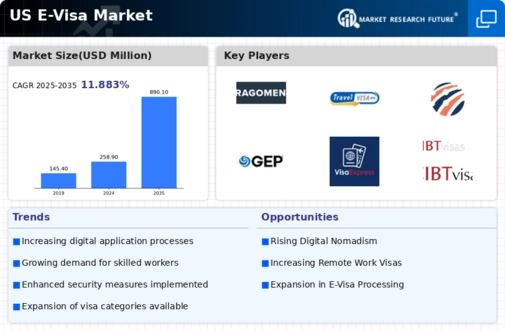The e passport-e-visa market is characterized by a dynamic competitive landscape, driven by technological advancements and increasing demand for secure travel documentation. Key players such as Thales (FR), HID Global (US), and IDEMIA (FR) are at the forefront, each adopting distinct strategies to enhance their market positioning. Thales (FR) focuses on innovation in biometric solutions, aiming to integrate advanced security features into their products. Meanwhile, HID Global (US) emphasizes partnerships with government agencies to streamline the issuance of e-passports and e-visas, thereby enhancing operational efficiency. IDEMIA (FR) is also notable for its commitment to digital transformation, leveraging AI and machine learning to improve identity verification processes. Collectively, these strategies contribute to a competitive environment that prioritizes security, efficiency, and technological integration.
In terms of business tactics, companies are increasingly localizing manufacturing to reduce costs and enhance supply chain resilience. This approach appears to be particularly relevant in the context of geopolitical tensions and supply chain disruptions. The market structure is moderately fragmented, with several key players exerting influence over various segments. The collective actions of these companies suggest a trend towards consolidation, as firms seek to enhance their capabilities through mergers and acquisitions.
In October 2025, Thales (FR) announced a strategic partnership with a leading technology firm to develop next-generation biometric systems for e-passports. This collaboration is expected to enhance the security features of their products, positioning Thales as a leader in biometric technology. The strategic importance of this partnership lies in its potential to address growing concerns over identity theft and fraud in travel documentation.
In September 2025, HID Global (US) launched a new e-visa solution that integrates seamlessly with existing government systems. This initiative is significant as it not only streamlines the visa application process but also enhances the user experience for travelers. By focusing on interoperability, HID The e passport-e-visa market position and foster long-term relationships with government clients.
In August 2025, IDEMIA (FR) expanded its operations in North America by opening a new facility dedicated to the production of secure travel documents. This move is indicative of IDEMIA's commitment to meeting the increasing demand for e-passports and e-visas in the region. The establishment of this facility is expected to enhance production capacity and reduce lead times, thereby improving service delivery.
As of November 2025, current trends in the e passport-e-visa market include a strong emphasis on digitalization, sustainability, and the integration of AI technologies. Strategic alliances are increasingly shaping the competitive landscape, as companies recognize the value of collaboration in driving innovation. Looking ahead, it appears that competitive differentiation will evolve from traditional price-based competition to a focus on technological innovation, supply chain reliability, and enhanced customer experiences. This shift may redefine the parameters of success in the market, compelling companies to invest in cutting-edge technologies and sustainable practices.





















Leave a Comment